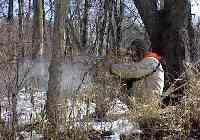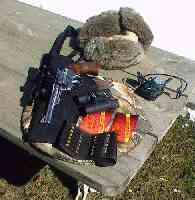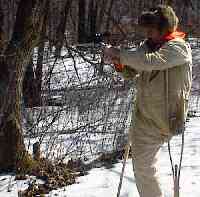by Joe Hecksel
|
Tom Henderson has been hunting deer with his .357 magnum for the last 9 years. He tagged 5 deer in those 9 years. Two of those deer were from state land in heavily populated southern Michigan. That is significantly better than the 30% batting rate of the typical Michigan firearms hunter. Tom, why are you so successful? "I think like a bow hunter," Tom says. "I don't take any shots over 20 yards in length. I look at a lot of deer before I pull the trigger. Most guys who try hunting with a pistol don't really buy into the range limitations. They will try 70 yard shots.
"Of course, it is even better if you know the bow hunters and they can tell you which stands are the best setups for pistols. Most bow hunters are pretty sociable once you get to know them." So how does a guy who takes fewer shots end up with more deer? "The biggest thing is that I am out there for the long haul. (This interview took place on the afternoon of the second day of the 2002 deer season.) Already this season there were three times when hunters went into the cabin to warm up and deer came down the trail 15 minutes later. I don't know if the deer heard them leave and that shook them loose. The thing is these were not spooked, running deer, and they came right down the trail these guys were hunting. Maybe the deer get cold and hungry the same time the hunters do. "The other thing is that I have been really lucky in where I get to hunt. I hunt a swamp about 400 acres in size. The swamp is shaped like a fist with a thumb that sticks out of it. The thumb is about 150 yards across by about 1000 yards in length and it sticks out into prime farmland—corn, winter wheat, alfalfa, beans. I hunt at the base of that thumb. "Location, location, location. It is hard for hunters who are just starting out to get prime spots. It helps to not be in competition with anybody. Some landowners and bow hunters are willing to get you started if you are willing to shoot does. It is a funny thing. Many people buy into the idea of quality deer management but just cannot bring themselves to shoot a doe." What firearm do you use? "I hunt with a Stainless Steel Taurus 661 .357 magnum with a 6" barrel. It is topped with a 1.5X pistol scope. Lately, I have been using CCI 158 grain Lightening hollowpoints."
"Why use expensive ammo? This ammo has done everything I ever asked it to do. I can afford to practice with it and every deer I shot with it dropped in its tracks, except for one that ran 60 yards. "I want to reload. I can afford to practice more if I 'roll my own.' My Uncle was going to show me how to do it. I got all the components together and then he was invited to help crew a boat for the season." Why a Taurus and why a .357 magnum? "Well, it was my grand-dad's gun, and he agreed to sell it to me. I had shot quite a few pistols, including several in the military, and this gun is a cherry. It has a great trigger, the hammer comes back very quietly and I can stay out in any kind of weather because it is stainless. I had the hots for a Raging Bull .44 magnum, but then I got to thinking, the .357 is more than enough gun for anything in Michigan and I shoot this gun very accurately." Is there anything you would change about this gun? "I would tell gun designers that all magnum pistols should have accommodations for scope mounts. I dropped $79 in getting a scope mount for the gun and there is no reason the top strap cannot be drilled and tapped or in the shape of a dovetail. It would be pretty convenient to be able to move my scope from one pistol to another without having to spend $79 for each pistol." What other pistols? "I recently bought a Ruger New Army .44 cap-and-ball black powder pistol. I want to take advantage of Michigan's black powder season." Why do you hunt with a pistol? "I hunt with a pistol to put meat on the table. I get pretty tired of eating chicken!
Do you bow hunt? "I tried but the logistics of carrying a bow were even worse than carrying a long gun. There is also the safety issue. I don't know how to shoot a bow and keep my crutches clamped under my arms. I sure don't want to fall on a quiver of broadheads." What do you do to stay in shape? "We do a lot of things outside as a family. We hunt mushrooms. We are really into paint-balling. You get a lot of practice moving over different kinds of terrain when you are paint-balling. In fact, I have a pair of crutches that are covered with camouflage." Who else should consider hunting with a pistol? "I think anybody who hunts in heavy cover or anyplace where they will need both hands free. Also, it has to be a hunter who is mature enough to let deer walk. You have to pick your shots." How do you decide where you are going to stand? "Well, Joe, that is really two questions. First you have to find a place to hunt. Then you need to look it over and the site will tell you how to set up. "When I hunt private land I hunt where the host wants me to hunt. Period. That is simply good manners. On a practical note, you have to believe that they want you to be successful and are putting you in a spot where they think you will see deer. The other thing is that there are likely to be other hunters on the property. A good host will put you in a place where you are not down range of anybody else's shooting lanes. "Some of the places I hunt are little 5 and 10 acre islands of cover in agricultural areas. I check them out during squirrel season, mostly to scout out the deer trails. Then, during deer season I approach them from either down or cross wind in case the deer are bedded up in the cover. Then I post up 15 yards cross wind from the dominant outbound deer trail on the downwind side. If there is any elevation difference, I like to be on the up-hill side so any stray shots will go into the dirt. I like to be very close to the edge of the cover. There is usually a deer trail that is ten to twenty yards inside the brush and runs parallel to the edge of the cover. Where I set up is dictated by my 20 yard shot. It is really very logical. From that place I can cover the dominant trail, the secondary trail, any bucks working scrape lines along the edge. "For state land I like the parcels sitting off by themselves. The state acquires land a parcel at a time. A game area will have a large block of land and then there will be a sprinkling of separate parcels scattered around it. I like to hunt those separate parcels because they get less pressure." Any tips on recovering deer? "One of the handiest pieces of equipment I have is the two-way radio. Everybody on the property sets them to the same channel. Some guys leave them on all the time and use an ear bud. Other guys just monitor them for the five minutes after a shot is fired. We kind of coordinate when we will track the deer that have been shot. The guys who got the shot will typically stay on their stand and direct the other guys in "cutting-the-trail." A lot of times you will not get a blood trail the first 50 or 100 yards or so. Things look a lot different as the perspective changes. A tree with the distinctive fork looks different when you are right under it. "Then we will team track once we have a decent blood trail. One guy stands on the last sign facing general direction of travel. He is usually squatting because that helps him see any blood on grass. Then we have two or three other guys fan out ahead and look for the next sign. When one of those guys finds some sign, the other two guys "take a line" on the guy in back and the new sign. Every so often we will mark the trail with a square of toilet paper. "I have only had to drag one deer out myself. That is one I got on state land. I gutted it out. Then I dragged it out, skidding it 18" at a time. I rested when I got tired. I threw it into the trunk of my car when I got to the road. "I have to laugh at these guys who buy trail monitors and attempt to pattern deer. They are caught up in the time-card mentality. They want to show up at 8:34 AM and shoot a deer at 8:35. To me, if it takes two hours to track a deer and two hours to haul it out to the road, it is no big deal. So what if it takes me a little longer. "I gotta admit that my kids dragged out most of my deer. I start taking them with me when they turn 12. They get pretty excited. They all like eating deer meat. They know that this is the real deal. I have three teen-age kids that I am really proud of." So any words of wisdom on how to raise kids who like hunting? "Yeah. There is no one simple answer, but taking them with me into the woods since they were small has worked for me. It is part of our family heritage."
Photos copyright 2003 by Jeannie Henderson |


